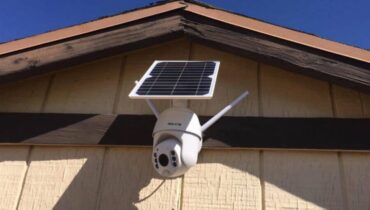Table of Contents
In today’s era of increasing energy costs and environmental consciousness, harnessing solar power through the use of solar panels has become more important than ever. However, the initial expense of purchasing and installing commercial solar panels can be a significant deterrent for many individuals and households.
If you’re looking to transition to clean, renewable energy without breaking the bank, consider the option of building your own inexpensive solar panels. In this comprehensive guide, we’ll walk you through the steps to create affordable solar panels that not only reduce your energy bills but also contribute to a more sustainable future.
Step 1: Choose Your Cell Voltages & Power Output
Before diving into the construction process, it’s essential to determine the voltage and power output you require from your solar panel. To calculate this, consider your energy consumption and the number of solar cells you plan to use. Solar cells come in various voltages and power ratings, so choose ones that match your needs while staying within your budget.
When choosing your cell voltages and power output for your cheap solar panels, consider your energy needs and whether you’re connecting to the grid or going off-grid. Higher voltage cells are suitable for grid-tied systems, while lower voltage cells are better for off-grid setups. Achieving the perfect equilibrium between voltage, power output, and cost is essential for the success of your solar panel project, especially when utilizing a cheap solar generator.
Understanding Cell Voltages and Power
Before you embark on your journey to create cheap solar panels, it’s crucial to have a solid understanding of cell voltages and power output. Solar cells come in various voltage ratings and power outputs, and your choice here can significantly impact the cost and efficiency of your panels.
Solar cells are typically rated at voltages such as 12V, 24V, or even higher. Understanding the voltage rating is crucial as it signifies the amount of electrical potential the cell can produce, a consideration applicable even when opting for cheap solar pool covers. Higher voltage cells are more suitable for grid-tied systems, while lower voltage cells are ideal for off-grid setups.
Calculating Your Energy Needs
To determine the right cell voltages and power output for your solar panels, you must calculate your energy needs. Analyze your electricity consumption over time and identify your peak usage periods. This information will help you decide how many solar panels you need and what wattage they should be to meet your energy demands.
While contemplating the use of cheap solar lights, it’s important to be mindful that over-sizing your solar panel system can result in unnecessary expenses., so strike a balance between your energy requirements and the panel’s cost.
Balancing Cost and Efficiency
When considering the installation of solar panels, it’s important to strike a balance between cost and efficiency to determine whether is it cheaper to have solar panels in the long run. Higher efficiency panels tend to be more expensive but can generate more electricity in limited space. Conversely, lower efficiency panels are more affordable but require more surface area to produce the same amount of energy.
Consider your budget and space availability while selecting solar cells. Remember that a combination of moderately efficient panels can sometimes be a cost-effective solution without compromising performance.
Step 2: Planning Your Panel Layout
When planning your solar panel layout, start by assessing the available space and the direction of sunlight. Optimal orientation is typically south-facing in the northern hemisphere and north-facing in the southern hemisphere to maximize sun exposure. Ensure that panels are tilted at an angle equal to your latitude for year-round efficiency.
Consider the spacing between panels to avoid shading, which can reduce overall energy production. Rows should be spaced apart adequately to minimize shadow casting on adjacent panels. Finally, think about cell placement to maximize the use of available space, ensuring that no obstructions obstruct sunlight from reaching your solar panels. When exploring options such as used solar panels for sale cheap, planning a well-thought-out layout becomes essential for achieving optimal energy generation and cost savings.
Orientation and Tilt Angle
Determining the correct orientation and tilt angle for your solar panels is essential to maximize their energy production. Proper alignment ensures that your panels receive the optimal amount of sunlight throughout the day. Discovering the optimal orientation and tilt angle is crucial for maximizing the efficiency of your cheap solar panels.
Shading Analysis
Identify potential sources of shading such as trees, buildings, or other obstructions. Position your solar panels to minimize shading during peak sunlight hours, ensuring maximum energy capture.
Conducting a shading analysis is a critical step in optimizing the performance of your cheap solar panels. Shading poses a considerable threat to the efficiency of your solar array by obstructing sunlight from reaching the panels, particularly concerning cheap solar lights for yard. Here’s how to perform a shading analysis:
Step 3: Tabbing Your Solar Cells
When tabbing your solar cells, begin by carefully cleaning the cell surfaces to remove any contaminants or oxidation. This ensures a proper soldering connection. Use a flux pen to apply flux to both the cell and the tabbing wire. This helps facilitate a strong and clean solder joint.
Next, gently solder the tabbing wire onto the solar cell, making sure to apply even pressure and avoid overheating, which can damage the cell. Use a soldering iron with temperature control to maintain the right soldering temperature.
Ensure that you follow all safety guidelines, including working in a well-ventilated area and wearing safety goggles and heat-resistant gloves. Proper tabbing is essential for creating an efficient and reliable solar panel that can harness solar energy effectively.
Step 4: Connecting the Bus Wires
Connecting the bus wires is a critical step in assembling your solar panel. Refer to your wiring diagram or schematic to identify the correct arrangement of cells and bus wire connections. Start by laying out the cells in the desired configuration, ensuring that they are evenly spaced and aligned.
Carefully attach the bus wires to the soldered tabs on the solar cells, making sure to maintain the correct polarity and series or parallel configuration as indicated in your diagram. Use appropriate connectors or soldering techniques to secure the connections firmly.
- Series vs. Parallel Connection: Understand the benefits and trade-offs of series and parallel connections and choose the configuration that suits your energy needs and system design.
- Proper Soldering: Ensure that you use proper soldering techniques to secure bus wires and create efficient electrical connections. Reliable connections are crucial for maximizing energy production.
- Voltage and Current Testing: Regularly test the voltage and current output of your connected solar cells to ensure they meet your desired specifications. Adjust connections if necessary to achieve the desired output.
Step 5: Protect the Cells With the Glass
To protect the solar cells from environmental factors and ensure longevity, sandwich them between a protective glass layer and a backing material. Seal the edges with a suitable adhesive to prevent moisture from seeping in. This step also contributes to the overall durability of your DIY solar panel. Here’s how to safeguard your cells with a glass layer:
- Temperature Considerations: Take into account the temperature conditions in your location when deciding on a series or parallel connection. Series connections can be more sensitive to shading and temperature variations, while parallel connections may be more robust in such situations.
- System Scalability: Consider the scalability of your solar panel system. Parallel connections can be more straightforward to expand by adding more panels, while series connections may require adjustments to maintain compatibility with your inverter or charge controller.
- Safety Precautions: When soldering, prioritize safety by working in a well-ventilated area, using appropriate safety gear, and ensuring that you follow the manufacturer’s guidelines for the soldering equipment. This helps prevent accidents and damage to your solar cells.
- Monitoring and Maintenance: Continuously monitor the performance of your solar panel system by regularly checking voltage and current outputs. Implement a maintenance schedule to clean and inspect the panel for any issues that might affect efficiency, such as dust or debris accumulation, and address them promptly.
- Inverter and Charge Controller Compatibility: Ensure that your chosen connection configuration aligns with the specifications of your inverter or charge controller. Some inverters may be more suitable for series-connected panels, while others are designed for parallel configurations. Check compatibility to optimize energy conversion.
- Battery Integration: If you’re using batteries to store excess energy, consider how your series or parallel configuration affects battery charging and discharging. This can impact the overall efficiency and longevity of your energy storage system.
- Documentation: Maintain comprehensive records of your solar panel design, soldering processes, and testing results. This documentation will be valuable for troubleshooting, future expansion, and warranty claims, ensuring the long-term reliability of your solar panel system.
Step 6: Mount the Terminal Box
To safely channel the electricity generated by your solar panel, mount a terminal box on the panel’s backside. The terminal box allows you to connect the panel to your energy system or store the electricity in batteries for later use. Make sure to follow electrical safety guidelines while installing the terminal box.
By following these steps and investing your time and effort, you can create your own inexpensive solar panels that provide clean, renewable energy. When constructing your solar panel setup, it’s essential to prioritize safety and comply with local regulations, especially when incorporating cheap solar lights outdoor use.
FAQs
Q1: How much money can I save by building my own solar panels?
A1: The amount you can save depends on various factors, including your energy consumption, the efficiency of your DIY solar panel, and local energy prices. On average, DIY solar panels can offer substantial long-term savings.
Q2: Are DIY solar panels as efficient as commercial ones?
A2: The efficiency of DIY solar panels can vary, but with careful planning and quality materials, you can achieve high levels of efficiency that are comparable to commercial panels.
Q3: Is it legal to install DIY solar panels in my area?
A3: Regulations regarding DIY solar panel installations vary by location. Check with your local authorities and utility providers to ensure compliance with all applicable laws and codes.
Conclusion
In conclusion, constructing your inexpensive solar panels is a fulfilling project that not only saves you money but also allows you to contribute to a sustainable future. As you embark on this journey, remember to consult local experts, join relevant online communities, and engage with like-minded individuals to share your experiences and learn from others. By following these guidelines, you can create affordable solar panels that make a positive impact on your energy bills and the environment.
By understanding the benefits, choosing the right components, sourcing materials wisely, and following proper assembly and installation techniques, you can create an affordable solar panel system that benefits both your budget and the planet. Embrace the power of solar energy and embark on a sustainable journey toward a greener future.

